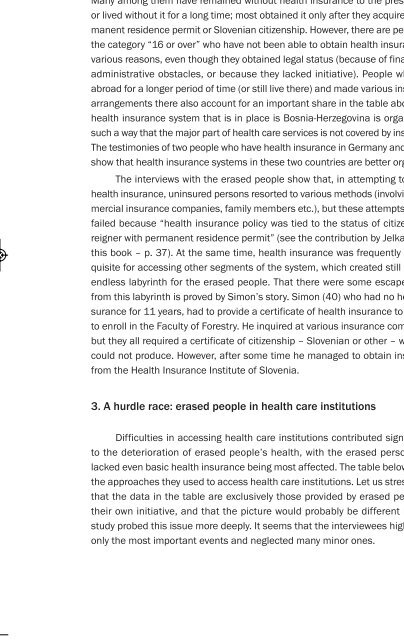The Scars of the Erasure_web
The Scars of the Erasure_web
The Scars of the Erasure_web
- No tags were found...
Create successful ePaper yourself
Turn your PDF publications into a flip-book with our unique Google optimized e-Paper software.
<strong>Erasure</strong>_4a 10.1.11 20:29 Page 177ERASED RIGHTS, INVISIBLE DISEASES177It is clear from <strong>the</strong> table above that <strong>the</strong> percentage <strong>of</strong> people who had continuoushealth insurance is low (15.25 percent). <strong>The</strong>se were mainly persons wholost <strong>the</strong>ir jobs after <strong>the</strong> erasure but were able to obtain status based on temporarywork permits. <strong>The</strong> share <strong>of</strong> non-insured people is much larger (66.10 percent).Many among <strong>the</strong>m have remained without health insurance to <strong>the</strong> present day,or lived without it for a long time; most obtained it only after <strong>the</strong>y acquired a permanentresidence permit or Slovenian citizenship. However, <strong>the</strong>re are persons in<strong>the</strong> category “16 or over” who have not been able to obtain health insurance forvarious reasons, even though <strong>the</strong>y obtained legal status (because <strong>of</strong> financial oradministrative obstacles, or because <strong>the</strong>y lacked initiative). People who livedabroad for a longer period <strong>of</strong> time (or still live <strong>the</strong>re) and made various insurancearrangements <strong>the</strong>re also account for an important share in <strong>the</strong> table above. <strong>The</strong>health insurance system that is in place is Bosnia-Herzegovina is organized insuch a way that <strong>the</strong> major part <strong>of</strong> health care services is not covered by insurance.<strong>The</strong> testimonies <strong>of</strong> two people who have health insurance in Germany and Austriashow that health insurance systems in <strong>the</strong>se two countries are better organized.<strong>The</strong> interviews with <strong>the</strong> erased people show that, in attempting to obtainhealth insurance, uninsured persons resorted to various methods (involving commercialinsurance companies, family members etc.), but <strong>the</strong>se attempts usuallyfailed because “health insurance policy was tied to <strong>the</strong> status <strong>of</strong> citizen or fo -reigner with permanent residence permit” (see <strong>the</strong> contribution by Jelka Zorn inthis book – p. 37). At <strong>the</strong> same time, health insurance was frequently a prere -quisite for accessing o<strong>the</strong>r segments <strong>of</strong> <strong>the</strong> system, which created still ano<strong>the</strong>rendless labyrinth for <strong>the</strong> erased people. That <strong>the</strong>re were some escape routesfrom this labyrinth is proved by Simon’s story. Simon (40) who had no health insurancefor 11 years, had to provide a certificate <strong>of</strong> health insurance to be ableto enroll in <strong>the</strong> Faculty <strong>of</strong> Forestry. He inquired at various insurance companies,but <strong>the</strong>y all required a certificate <strong>of</strong> citizenship – Slovenian or o<strong>the</strong>r – which hecould not produce. However, after some time he managed to obtain insurancefrom <strong>the</strong> Health Insurance Institute <strong>of</strong> Slovenia.3. A hurdle race: erased people in health care institutionsDifficulties in accessing health care institutions contributed significantlyto <strong>the</strong> deterioration <strong>of</strong> erased people’s health, with <strong>the</strong> erased persons wholacked even basic health insurance being most affected. <strong>The</strong> table below shows<strong>the</strong> approaches <strong>the</strong>y used to access health care institutions. Let us stress againthat <strong>the</strong> data in <strong>the</strong> table are exclusively those provided by erased people on<strong>the</strong>ir own initiative, and that <strong>the</strong> picture would probably be different had <strong>the</strong>study probed this issue more deeply. It seems that <strong>the</strong> interviewees highlightedonly <strong>the</strong> most important events and neglected many minor ones.


